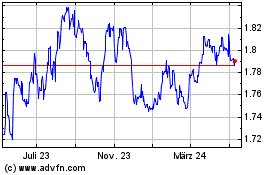Australian, NZ Dollars Firm As Commodity Prices Gain
22 Dezember 2021 - 9:17AM
RTTF2
The Australian and NZ dollars strengthened against their major
counterparts in the European session on Wednesday, as commodity
prices rose, Omicron worries eased a bit and China pledged more
measures to support the economy.
Oil prices gained after a data from the American Petroleum
Institute showed that U.S. crude inventories fell by 3.7 million
barrels last week.
U.S. President Joe Biden pledged that the country will not go
back to lockdowns, adding that it is Americans' "patriotic duty" to
get vaccinated.
Biden told the government will provide 500 million free rapid
home-testing kits, increase assistance to hospitals and ramp up
vaccination and booster programs.
In an interview with Xinhua News Agency, Ning Jizhe, Deputy Head
of the National Development and Reform Commission, said that the
Chinese government will boost spending, enhance support to
manufacturers and small companies and protect price stability.
Beijing is determined to implement proactive fiscal policies,
increase efforts to build an integral domestic market and further
reduce the negative list regarding foreign investment, he
added.
Data from Westpac showed that Australia's leading index improved
in November but remained slightly negative.
The six-month annualized growth rate in the Westpac-Melbourne
Institute Leading Index rose to -0.2 percent in November from -0.5
percent in October.
Survey data from ANZ showed that New Zealand consumer confidence
improved for the first time in six months in December.
The ANZ-Roy Morgan consumer confidence index rose to 98.3 in
December from 96.6 in the previous month. However, the index
remained well below its long-term average of 120.
The aussie advanced to a 5-day high of 0.7171 against the
greenback and a 6-day high of 81.93 against the yen, off its early
lows of 0.7121 and 81.26, respectively. The next possible
resistance for the aussie is seen around 0.74 against the greenback
and 84.00 against the yen.
The aussie rose back to 1.5754 against the euro, not far from a
6-day high of 1.5752 seen in the Asian session. If the aussie rises
further, it may find resistance around the 1.54 level.
The aussie rebounded to 1.0576 against the kiwi, from a low of
1.0554 set at 5:45 pm ET. On the upside, 1.07 is seen as its next
likely resistance level.
The aussie hit 0.9256 against the loonie, its highest level
since November 2. The aussie is poised to find resistance around
the 0.94 area.
The NZ currency appreciated to a 5-day high of 0.6783 against
the greenback and a 6-day high of 77.51 against the yen, up from
its previous lows of 0.6740 and 76.92, respectively. The kiwi is
seen finding resistance around 0.70 against the greenback and 79.00
against the yen.
The kiwi recovered to 1.6649 against the euro, heading to pierce
its Asian session's 2-day high of 1.6646. The kiwi may face
resistance around the 1.64 region.
Looking ahead, U.S. GDP data for the third quarter and existing
home sales for November will be published in the New York
session.
Euro vs NZD (FX:EURNZD)
Forex Chart
Von Mär 2024 bis Apr 2024

Euro vs NZD (FX:EURNZD)
Forex Chart
Von Apr 2023 bis Apr 2024
